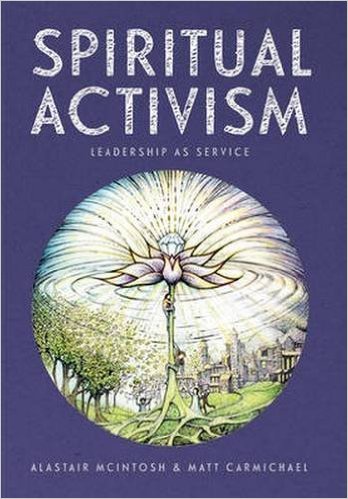 Spiritual Activism: Leadership as service by Alastair McIntosh and Matt Carmichael
Spiritual Activism: Leadership as service by Alastair McIntosh and Matt Carmichael
Reviewed by David Lorimer
As I mention in my review of Terra Nova in this section, Dieter Duhm’s experience of Marxism in the 1960s was that politics alone was not enough, and had to be underpinned by spirituality and community. The authors of this thoughtful and practical book, which originates in a university course, have not only taken this on board but help others tread a path where action is informed not only by spirituality in general, but by spiritual practice and psychological understanding. The ten chapters cover the nature of activism and spirituality, the implications of higher consciousness and the structure of the psyche, leadership and consciousness-raising, the pitfalls of cults and charisma, the practice of nonviolence, the psychodynamics of campaigning and some examples of deeper practice that can inform our action.
To be an activist is not comfortable: it involves standing apart from and holding a mirror to society, having ascertained one’s position on an issue and taken the decision to act in a particular way. One becomes part of a group with its own psychodynamics that need to be understood for effective campaigning. As the authors note, spirituality involves values, an inner life and an intrinsic relationship between knowing, being and doing. To be authentic in this respect means living from the heart and manifesting love in all situations, however challenging. The authors give a number of experiences of their own, including a rather dramatic encounter with RD Laing on Iona. They justify both spirituality and the relevance of higher consciousness before exploring the structure of the psyche with particular reference to Freud, Jung and Maslow, but also to Assagioli, Reich and Alice Miller.
I found their discussion of movers and movements very helpful, and especially the definition of conscientisation as ‘the raising of the consciousness and conscience through action and reflection so that people think critically about their lives, enabling transformation towards a fuller humanisation.’ They use power-with rather than power-over, although these relationships can be very complex within the group, for instance between visionaries and managers. I also liked the definition of a prophet as ‘a visionary who gives outward witness to an inner calling’, often highlighting social or environmental injustice. They relate this role both to the shaman and the bard. The chapter on cults contains some useful caveats in terms of group dynamics and the downside of charisma.
Their discussion on nonviolence draws on the work of Joanna Macy and also Walter Wink, whom I had not come across. His myth of redemptive violence is very relevant to our current situation in the Middle East and indeed the political reaction to it, that ‘violence saves, that war brings peace, that might makes right.’ However, this all takes place within what Wink called the domination system characterising Western societies. Perhaps our greatest spiritual challenge as a species is breaking this spiral of violence, which is where authentic nonviolence comes in. The authors see this as the delegitimisation of legitimate power through choosing suffering in preference to the perpetuation of violence. This is the moral power of those, like Gandhi, who choose this path of satyagraha or truth force. They give examples from a number of traditions, including Mohammed himself in one of the excellent case studies at the end of each chapter – these also include Julia Butterfly Hill, Desmond Tutu, Gerard Winstanley and Sojourner Truth.
The last two chapters provide further tools for the activist including circles of trust for feedback and growth, the importance of eldership and the need to work on inner transformation and maintain one’s integrity. Alastair tells a delightful story about a pedlar coming to the door in Darjeeling with the number of offerings, among which was a Buddhist prayer wheel. The man pronounced the formula Om mane padme hum, and when Alastair asked him what these words really meant, he replied ‘God come to my heart’. The authors also explain how to practise the metta meditation for compassion, extending it not only to friends but also strangers and those we dislike. Alastair recounts a significant dream that uncannily mirrors the situation of one of the workshop attendees.
Many readers will find themselves somewhere between the spiritual and the activist part of the title. Regardless of where you are, this book will help infuse your activism with spirituality or awaken your spirituality to the need for a more active expression. We are all in the business of relating inner knowing and being to outer action and need to gain the maximum clarity in this respect if our motives and actions are to be consistent and anchored in moral values and ethical principles. The book takes the reader on an inspiring and hopeful journey.
For further details see www.alastairmcintosh.com/spiritualactivism/
